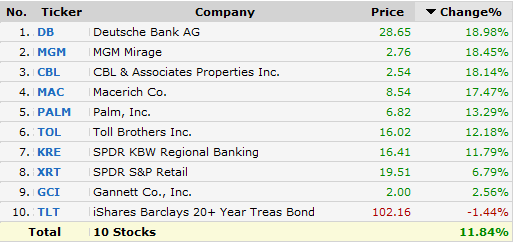Short Covering Driving Today’s Gains
One of the best ways to determine how much short covering is behind bear market rallies is to create a portfolio consisting of stocks and ETFs for which there is a large outstanding short interest.
With an eye toward sorting out short-covering activity in a future rally, I put together one such portfolio yesterday, using the Finviz.com screener to identify high volume securities where short positions are a large percentage of the float.
The results are below and show that the ten stocks in this portfolio are up an average of 11.8% halfway through today’s session, suggesting that short covering is fueling a large portion of today’s rally. Note that 7 of the 10 holdings are up more than 11% today, led by Deutsche Bank (DB) and MGM Mirage (MGM).

[source: FINVIZ.com]


6 comments:
thanks for the link for finviz....never tried it before.
the optimist in me hopes that this bottom is like 2002 where the oct 02 bottom did not have the VIX spike up past the prior highs.
Since Merrill Lynch came out with that research report re. a VIX = 80 to call a final bottom, maybe the market will begin to climb the wall of worry now.
Finviz is a great tool -- or set of tools. They are mostly known for their heat maps, but their group data, screener and insider information are also helpful.
Getting back to the short covering portfolio, the full group (10 holdings) finished +17.1% today and the leaders were CBL (+46.5%) and MAC (+31.8%). TOL ended up the 7th best performer out of 10, but still was up 13% today.
Lots of short covering all the way up to the close.
Nice points Bill,
Back when one could buy on dips, seeking out the stocks that "worked" on an up day was a good guide to new positions... In this market, it could lead to a "fakeout" instead of "breakout" due to short interest.
Wonder if upside call interest would help identify or "finger" the shorts more since a long call is the natural put option on a short stock?
Hi Bill,
in the finviz.com screener what filter(s) do you use to find short interest on a stock? and what option within the filter(s) do you recommend using?
Thanks,
Juan J.
John,
Interesting question about call interest. As it is not a subject I have looked into, I would love to hear from anyone who has.
Juan Jo,
In Finviz, I used "Float Short" -- the total number of shares short divided by total amount of shares in the float [i.e., available to the public for trading], expressed as a percentage.
For the portfolio in the post, I used the maximum Finviz short float setting, over 30%, and also included some minimum volume data (average volume over 500,000 and current volume over 500,000), but my cutoff is somewhat arbitrary.
FWIW, I usually also use minimum market cap filters (to screen out micro caps and sometimes small caps too), but I did not do so in this screen.
This is probably sufficient, but you can always add filters for other categories, such as minimum price, optionable, stocks only, etc.
Ultimately the decisions are personal ones and there is not necessarily a best choice.
Cheers and good luck,
-Bill
John, Interesting question about call interest. As it is not a subject I have looked into, I would love to hear from anyone who has. Juan Jo, In Finviz, I used "Float Short" -- the total number of shares short divided by total amount of shares in the float [i.e., available to the public for trading], expressed as a percentage. For the portfolio in the post, I used the maximum Finviz short float setting, over 30%, and also included some minimum volume data (average volume over 500,000 and current volume over 500,000), but my cutoff is somewhat arbitrary. FWIW, I usually also use minimum market cap filters (to screen out micro caps and sometimes small caps too), but I did not do so in this screen. This is probably sufficient, but you can always add filters for other categories, such as minimum price, optionable, stocks only, etc. Ultimately the decisions are personal ones and there is not necessarily a best choice. Cheers and good luck, -Bill
Post a Comment